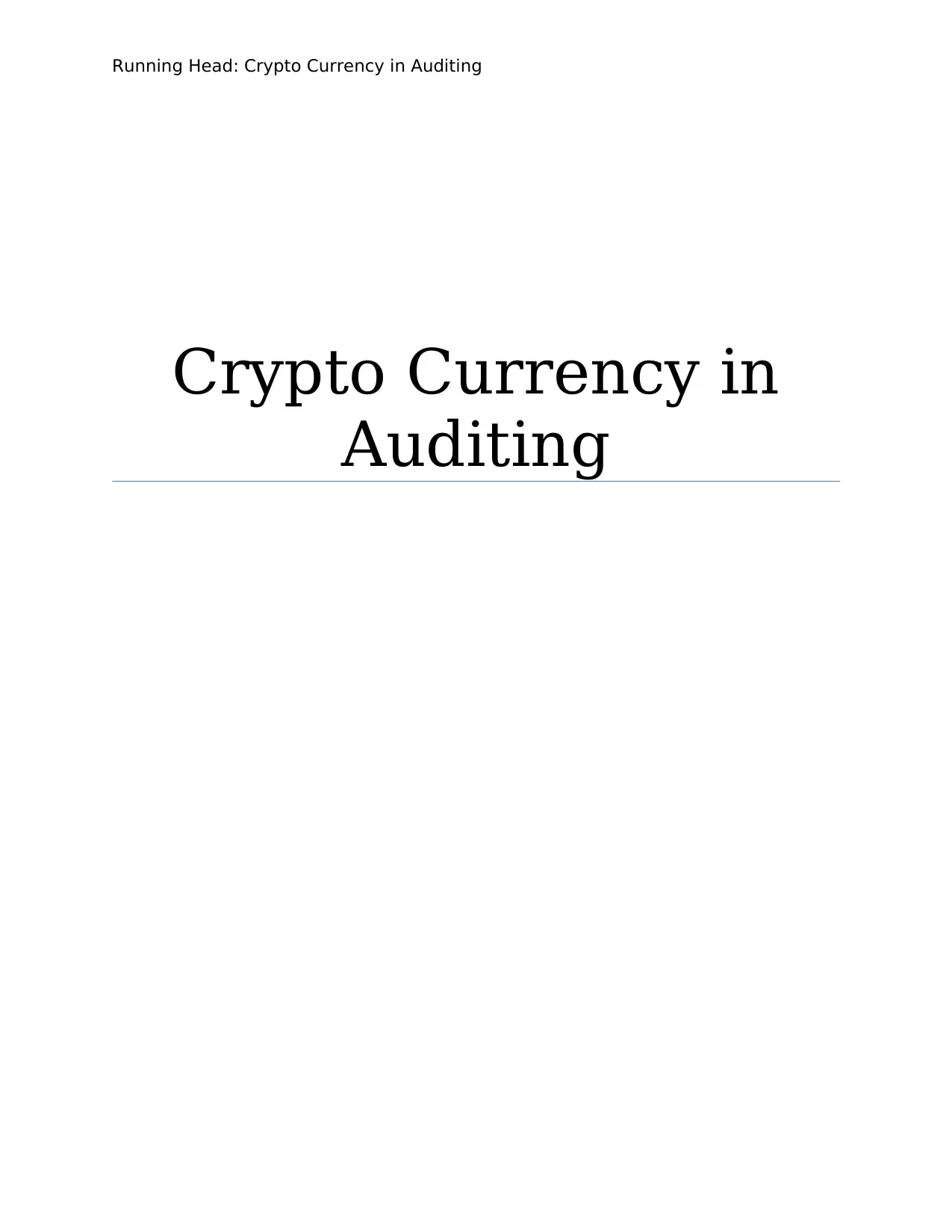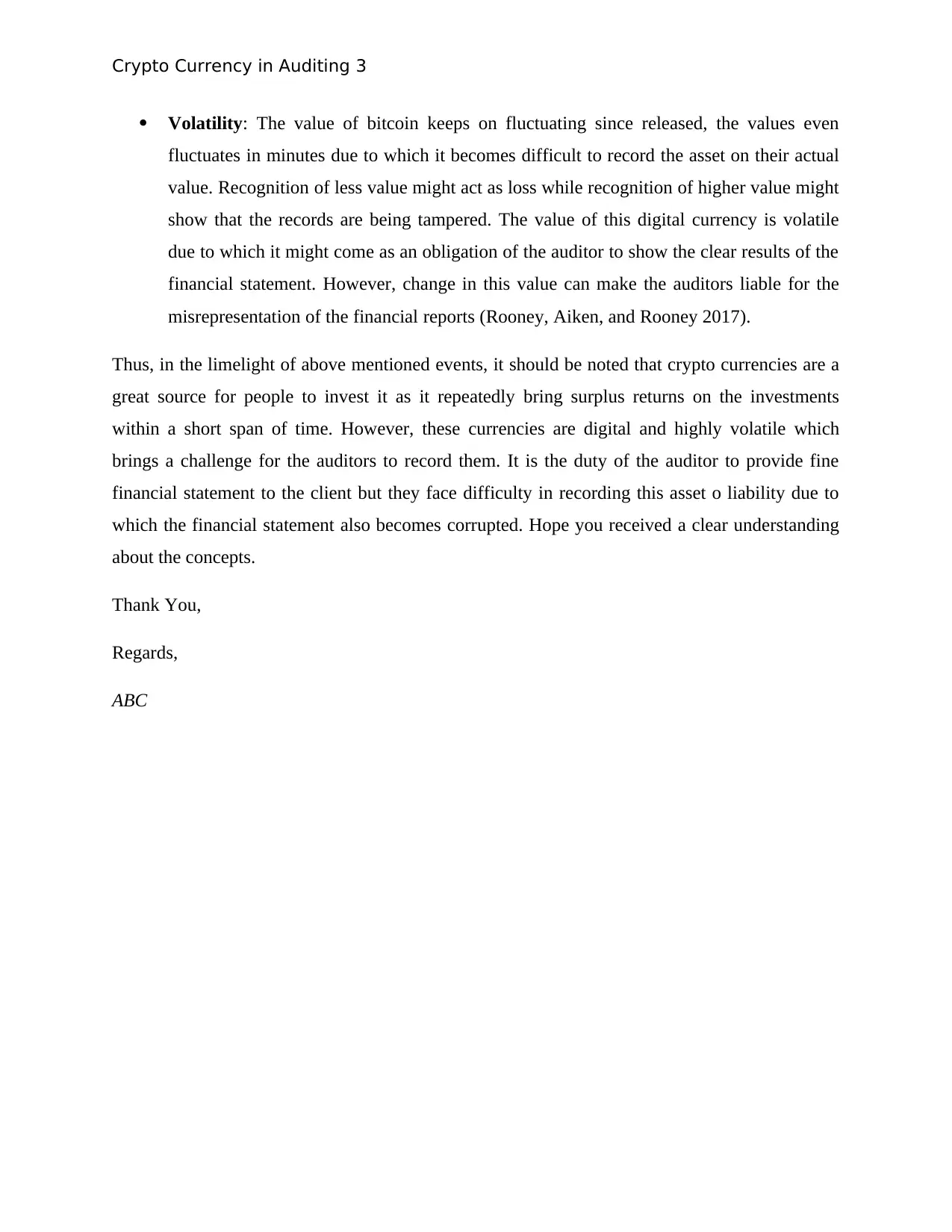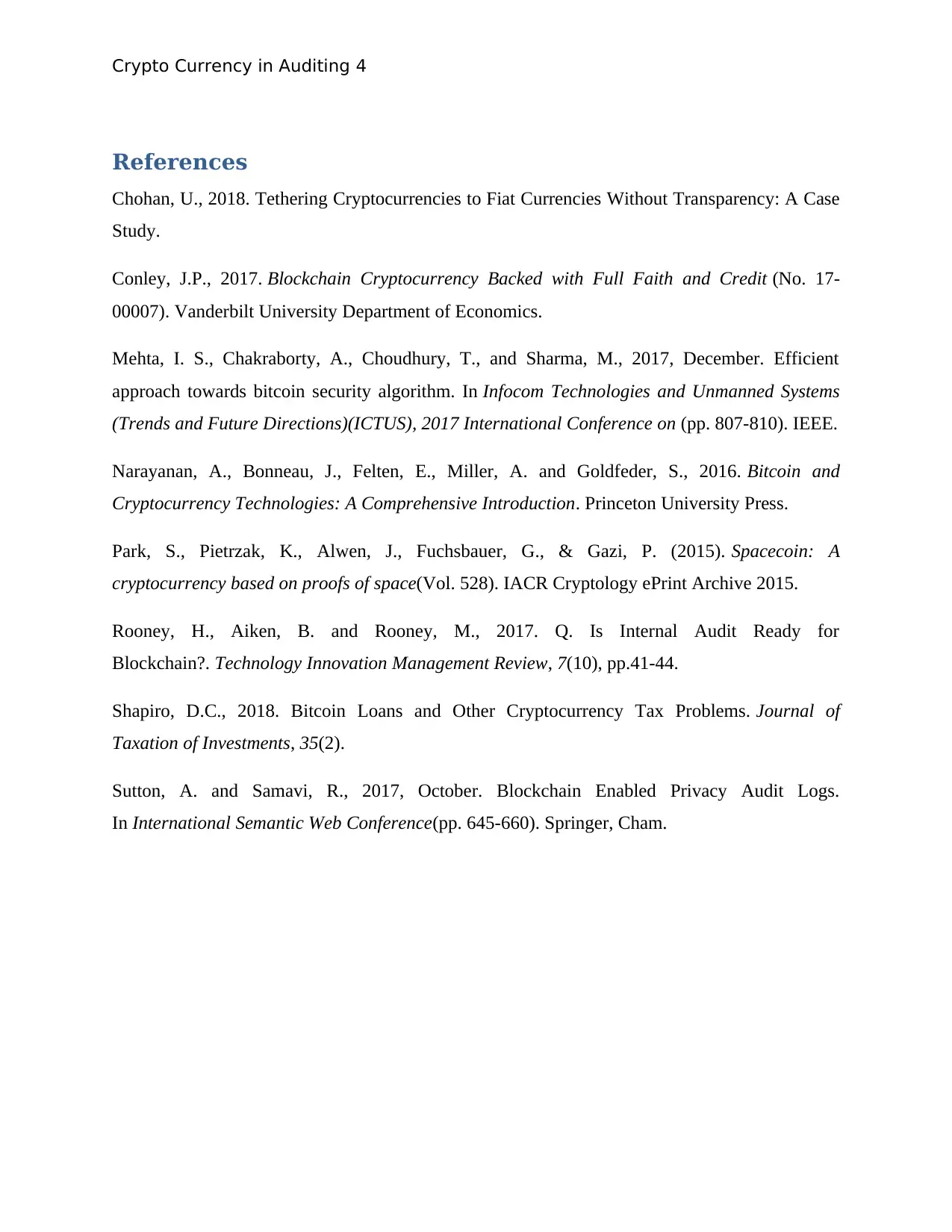Auditing Crypto Currencies: Challenges, Risks, and Implications
VerifiedAdded on 2021/04/17
|5
|1371
|56
Report
AI Summary
This report addresses the challenges auditors face when auditing crypto currencies. It begins by defining crypto currencies and their decentralized nature, contrasting them with traditional banking systems. The report then delves into specific auditing challenges, including revenue recognition and taxation complexities due to the uncertain classification of crypto assets, the lack of transparency and potential for money laundering, and the high volatility of crypto values, which can impact financial reporting accuracy. The report highlights the difficulties in valuing and accounting for these digital assets, emphasizing the need for auditors to adapt to the evolving financial landscape. It concludes by underscoring the significant challenges that auditors must overcome when dealing with these digital assets, emphasizing the importance of understanding the specific risks and implications associated with crypto currencies to provide accurate financial statements.

Running Head: Crypto Currency in Auditing
Crypto Currency in
Auditing
Crypto Currency in
Auditing
Paraphrase This Document
Need a fresh take? Get an instant paraphrase of this document with our AI Paraphraser

Crypto Currency in Auditing 1
To: XYZ@gmail.com
From: ABC@gmail.com
Subject: Crypto Currency and Challenges in Auditing
Dear Reader,
The purpose of this mail is to provide a brief overview about crypto currencies and the
challenges faced by the auditors while auditing the crypto currencies. Crypto currencies are
currently spamming the environment, as they are one good source to earn income for people. In
addition, there are many crypto currencies present in the environment (Narayanan, et. al., 2016).
Further the below mentioned report explains the meaning of crypto currencies and the challenges
related to them.
A crypto currency is a digital currency that is created electronically and can be stored
electronically in blockchains as well. This currency uses the encryption techniques to control the
creation of monetary units and to verify the transfer of funds. Thus, this currency is very secure
and safe as well. This is a digital asset that is designed to work as a medium of exchange (just
like normal currency); it uses cryptography to secure its transactions. These are the virtual
currencies are used in the stock market to increase the return on investments. The process
opposes to the centralized electronic money and central banking systems (Park, et. al., 2015).
The decentralized system of crypto currencies works through blockchains (public transaction
database).
Like, bitcoin, it was the first crypto currency introduced in the market in the year 2009. After
bitcoin, many virtual currencies were introduced in the market. These currencies are frequently
called altcoins, coming from the blend of alternative coins. In central banking systems, the
Federal Reserve System, government etc. hold, control and supply the flow of currency and
printing as well. Nevertheless, in the case of decentralized system of crypto currency, the firms,
governments do not hold the authority to produce new crypto currencies in environment. A
group of individuals known as Satoshi Nakamoto bases crypto currency on a technical system
that was created (Mehta, Chakraborty, Choudhury, and Sharma 2017). Now, after bitcoin
thousands of crypto currencies have appeared that work just like bitcoin in the environment.
To: XYZ@gmail.com
From: ABC@gmail.com
Subject: Crypto Currency and Challenges in Auditing
Dear Reader,
The purpose of this mail is to provide a brief overview about crypto currencies and the
challenges faced by the auditors while auditing the crypto currencies. Crypto currencies are
currently spamming the environment, as they are one good source to earn income for people. In
addition, there are many crypto currencies present in the environment (Narayanan, et. al., 2016).
Further the below mentioned report explains the meaning of crypto currencies and the challenges
related to them.
A crypto currency is a digital currency that is created electronically and can be stored
electronically in blockchains as well. This currency uses the encryption techniques to control the
creation of monetary units and to verify the transfer of funds. Thus, this currency is very secure
and safe as well. This is a digital asset that is designed to work as a medium of exchange (just
like normal currency); it uses cryptography to secure its transactions. These are the virtual
currencies are used in the stock market to increase the return on investments. The process
opposes to the centralized electronic money and central banking systems (Park, et. al., 2015).
The decentralized system of crypto currencies works through blockchains (public transaction
database).
Like, bitcoin, it was the first crypto currency introduced in the market in the year 2009. After
bitcoin, many virtual currencies were introduced in the market. These currencies are frequently
called altcoins, coming from the blend of alternative coins. In central banking systems, the
Federal Reserve System, government etc. hold, control and supply the flow of currency and
printing as well. Nevertheless, in the case of decentralized system of crypto currency, the firms,
governments do not hold the authority to produce new crypto currencies in environment. A
group of individuals known as Satoshi Nakamoto bases crypto currency on a technical system
that was created (Mehta, Chakraborty, Choudhury, and Sharma 2017). Now, after bitcoin
thousands of crypto currencies have appeared that work just like bitcoin in the environment.

Crypto Currency in Auditing 2
Further, most of the crypto currencies were designed just to decrease the production of physical
currency and place an ultimate cap on the total amount of currency that is being circulated. The
crypto currencies wallets store the public and private keys or address that are used to receive and
spend the crypto currency. With the help of private key, one can write on the public ledger and
spend the associated crypto currency and with the use of public key, it is probable for others to
send currency to the wallet. It should be noted that these crypto currencies are not formed,
printed or supplied physically; also they are not redeemable in another commodity like gold.
Bitcoin, PPcoin, Namecoin, Spacecoin and Litecoin are some examples of crypto currencies
present in the environment (Shapiro 2018).
A person cannot value something that is only present in the virtual world. As it is noticed above
that crypto currency is decentralized virtual money so the foremost difficulty faced by the
auditors is to accumulate them. This currency has also created misbalance in the financial world
as people do not know how to segregate them. Crypto currency cannot be actually regarded as a
currency, the auditors do not know how to interpret them, as derivatives or securities or
commodity as it can be segmented into any type (Chohan 2018).
Thus, due to this issue, the auditors find it difficult to present these crypto currencies into books
of accounts. Further the below mentioned are the issues faced by an audtor while accounting
crypto currencies in a company:
Revenue recognition and taxation: It is the duty of the auditor to evaluate the revenue
and tax which is to be paid by an organization. It is not known that bitcoin are an asset or
liability for the organization due to which they faces difficulty in revenue recognition and
taxation activities. The companies might be liable to penalties if the tax paid is not
relevant (Sutton, and Samavi 2017).
Transparency: it is another major challenge faced by the auditors, although the
transactions are completely transparent but the people related to the transaction are not
known to anyone. Thus, there might be a case of money laundering and the auditor
cannot identify this. Anonymity increases the chances of companies to act money-
laundering activities and it is the liability of the auditor analyzes it and finds the culprit
but due to lack of information they cannot complete this duty (Conley 2017).
Further, most of the crypto currencies were designed just to decrease the production of physical
currency and place an ultimate cap on the total amount of currency that is being circulated. The
crypto currencies wallets store the public and private keys or address that are used to receive and
spend the crypto currency. With the help of private key, one can write on the public ledger and
spend the associated crypto currency and with the use of public key, it is probable for others to
send currency to the wallet. It should be noted that these crypto currencies are not formed,
printed or supplied physically; also they are not redeemable in another commodity like gold.
Bitcoin, PPcoin, Namecoin, Spacecoin and Litecoin are some examples of crypto currencies
present in the environment (Shapiro 2018).
A person cannot value something that is only present in the virtual world. As it is noticed above
that crypto currency is decentralized virtual money so the foremost difficulty faced by the
auditors is to accumulate them. This currency has also created misbalance in the financial world
as people do not know how to segregate them. Crypto currency cannot be actually regarded as a
currency, the auditors do not know how to interpret them, as derivatives or securities or
commodity as it can be segmented into any type (Chohan 2018).
Thus, due to this issue, the auditors find it difficult to present these crypto currencies into books
of accounts. Further the below mentioned are the issues faced by an audtor while accounting
crypto currencies in a company:
Revenue recognition and taxation: It is the duty of the auditor to evaluate the revenue
and tax which is to be paid by an organization. It is not known that bitcoin are an asset or
liability for the organization due to which they faces difficulty in revenue recognition and
taxation activities. The companies might be liable to penalties if the tax paid is not
relevant (Sutton, and Samavi 2017).
Transparency: it is another major challenge faced by the auditors, although the
transactions are completely transparent but the people related to the transaction are not
known to anyone. Thus, there might be a case of money laundering and the auditor
cannot identify this. Anonymity increases the chances of companies to act money-
laundering activities and it is the liability of the auditor analyzes it and finds the culprit
but due to lack of information they cannot complete this duty (Conley 2017).
⊘ This is a preview!⊘
Do you want full access?
Subscribe today to unlock all pages.

Trusted by 1+ million students worldwide

Crypto Currency in Auditing 3
Volatility: The value of bitcoin keeps on fluctuating since released, the values even
fluctuates in minutes due to which it becomes difficult to record the asset on their actual
value. Recognition of less value might act as loss while recognition of higher value might
show that the records are being tampered. The value of this digital currency is volatile
due to which it might come as an obligation of the auditor to show the clear results of the
financial statement. However, change in this value can make the auditors liable for the
misrepresentation of the financial reports (Rooney, Aiken, and Rooney 2017).
Thus, in the limelight of above mentioned events, it should be noted that crypto currencies are a
great source for people to invest it as it repeatedly bring surplus returns on the investments
within a short span of time. However, these currencies are digital and highly volatile which
brings a challenge for the auditors to record them. It is the duty of the auditor to provide fine
financial statement to the client but they face difficulty in recording this asset o liability due to
which the financial statement also becomes corrupted. Hope you received a clear understanding
about the concepts.
Thank You,
Regards,
ABC
Volatility: The value of bitcoin keeps on fluctuating since released, the values even
fluctuates in minutes due to which it becomes difficult to record the asset on their actual
value. Recognition of less value might act as loss while recognition of higher value might
show that the records are being tampered. The value of this digital currency is volatile
due to which it might come as an obligation of the auditor to show the clear results of the
financial statement. However, change in this value can make the auditors liable for the
misrepresentation of the financial reports (Rooney, Aiken, and Rooney 2017).
Thus, in the limelight of above mentioned events, it should be noted that crypto currencies are a
great source for people to invest it as it repeatedly bring surplus returns on the investments
within a short span of time. However, these currencies are digital and highly volatile which
brings a challenge for the auditors to record them. It is the duty of the auditor to provide fine
financial statement to the client but they face difficulty in recording this asset o liability due to
which the financial statement also becomes corrupted. Hope you received a clear understanding
about the concepts.
Thank You,
Regards,
ABC
Paraphrase This Document
Need a fresh take? Get an instant paraphrase of this document with our AI Paraphraser

Crypto Currency in Auditing 4
References
Chohan, U., 2018. Tethering Cryptocurrencies to Fiat Currencies Without Transparency: A Case
Study.
Conley, J.P., 2017. Blockchain Cryptocurrency Backed with Full Faith and Credit (No. 17-
00007). Vanderbilt University Department of Economics.
Mehta, I. S., Chakraborty, A., Choudhury, T., and Sharma, M., 2017, December. Efficient
approach towards bitcoin security algorithm. In Infocom Technologies and Unmanned Systems
(Trends and Future Directions)(ICTUS), 2017 International Conference on (pp. 807-810). IEEE.
Narayanan, A., Bonneau, J., Felten, E., Miller, A. and Goldfeder, S., 2016. Bitcoin and
Cryptocurrency Technologies: A Comprehensive Introduction. Princeton University Press.
Park, S., Pietrzak, K., Alwen, J., Fuchsbauer, G., & Gazi, P. (2015). Spacecoin: A
cryptocurrency based on proofs of space(Vol. 528). IACR Cryptology ePrint Archive 2015.
Rooney, H., Aiken, B. and Rooney, M., 2017. Q. Is Internal Audit Ready for
Blockchain?. Technology Innovation Management Review, 7(10), pp.41-44.
Shapiro, D.C., 2018. Bitcoin Loans and Other Cryptocurrency Tax Problems. Journal of
Taxation of Investments, 35(2).
Sutton, A. and Samavi, R., 2017, October. Blockchain Enabled Privacy Audit Logs.
In International Semantic Web Conference(pp. 645-660). Springer, Cham.
References
Chohan, U., 2018. Tethering Cryptocurrencies to Fiat Currencies Without Transparency: A Case
Study.
Conley, J.P., 2017. Blockchain Cryptocurrency Backed with Full Faith and Credit (No. 17-
00007). Vanderbilt University Department of Economics.
Mehta, I. S., Chakraborty, A., Choudhury, T., and Sharma, M., 2017, December. Efficient
approach towards bitcoin security algorithm. In Infocom Technologies and Unmanned Systems
(Trends and Future Directions)(ICTUS), 2017 International Conference on (pp. 807-810). IEEE.
Narayanan, A., Bonneau, J., Felten, E., Miller, A. and Goldfeder, S., 2016. Bitcoin and
Cryptocurrency Technologies: A Comprehensive Introduction. Princeton University Press.
Park, S., Pietrzak, K., Alwen, J., Fuchsbauer, G., & Gazi, P. (2015). Spacecoin: A
cryptocurrency based on proofs of space(Vol. 528). IACR Cryptology ePrint Archive 2015.
Rooney, H., Aiken, B. and Rooney, M., 2017. Q. Is Internal Audit Ready for
Blockchain?. Technology Innovation Management Review, 7(10), pp.41-44.
Shapiro, D.C., 2018. Bitcoin Loans and Other Cryptocurrency Tax Problems. Journal of
Taxation of Investments, 35(2).
Sutton, A. and Samavi, R., 2017, October. Blockchain Enabled Privacy Audit Logs.
In International Semantic Web Conference(pp. 645-660). Springer, Cham.
1 out of 5
Related Documents
Your All-in-One AI-Powered Toolkit for Academic Success.
+13062052269
info@desklib.com
Available 24*7 on WhatsApp / Email
![[object Object]](/_next/static/media/star-bottom.7253800d.svg)
Unlock your academic potential
Copyright © 2020–2025 A2Z Services. All Rights Reserved. Developed and managed by ZUCOL.





